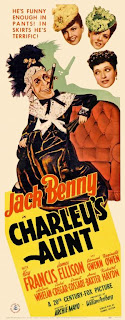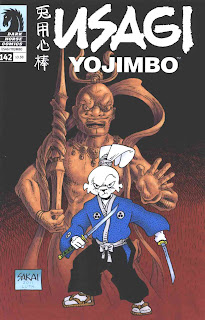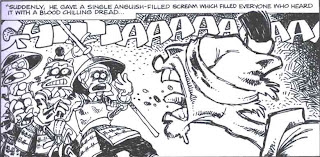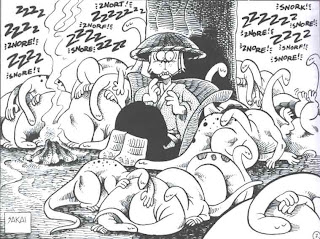Halloween caught me thinking about comic books which gave me a fright in the past. There are certainly some obvious books I could drag out for an entry in Unearthed...my first
Tomb of Dracula or
I, Vampire for instance. But no, I've decided to unearth the first comic book which scared me, the comic book I was often afraid to look at: my first issue of
Uncanny X-Men.
I was not a Marvelite growing up. My favourite comic books were Superman, Action Comics starring Superman, Justice League of America featuring Superman and perhaps something with Superman. However, a family friend who read nothing but Marvel comic books would occasionally divest himself of recent titles and they would wind up in our house; until my younger brothers came of age, they were usually my comics de facto. I kept them in a little brown suitcase.
So it was in 1982 at the tender age of four (I'm dating myself; no one else will) that Marvel's Uncanny X-Men#161 introduced me to the Holocaust. Hey kids! Comics!

It only seems fair to open with the cover, although I don't recall ever seeing it on my copy; young as I was, I would trash comics very quickly; I was lucky to retain all of the story pages, the cover was a small loss. Perhaps for that reason, the cover doesn't impress me now; it establishes the two principals of this story (Xavier & Magneto), supporting character Gabrielle Haller and the villains, Hydra.
We open on a nightmarish splash page which etched itself into my brain:

Xavier is in this state because of a recent story where the alien Brood kidnapped and did Stan-knows-what to him (spoiler: he's carrying a growing Brood inside his body). The X-Men (Cyclops, Storm, Colossus, Nightcrawler & Wolverine) have gathered at Xavier's bedside; with them his one-time lover Moira MacTaggert, current lover and alien princess Lilandra, Corsair of the space pirate team the Starjammers and the Starjammers' medic, Sikorsky.

At this time, the X-Men were living around the Bermuda Triangle in a base which Magneto had been utilizing in a storyline which wrapped up in issue #150 (I'll refer to that issue a few more times to come); the team's Westchester manor was recently destroyed and reconstruction would take a few more months of issues. Among the team is Cyclops, who had left the X-Men after Jean Grey's death (#137), handing the reigns of leadership over to Storm. It's interesting to note that while Cyclops is frequently considered the X-Men leader, he'd reunited with the team in #150 and was now almost a year back in the saddle without reclaiming the leader's position; he wouldn't lead the X-Men again 'til X-Men#1 (1991).
Cyclops is upset by Xavier's condition, particularly hearing how when the X-Men tried to use the alien psychic Oracle to wake him up, Xavier tried to commit suicide in response. This, of course, brings back Jean's suicide and Cyclops leaves to torment himself in private. Of the X-Men, Wolverine correctly guesses what's ailing Cyclops, noting their need for privacy is one of the few things they hold in common. Corsair, having recently revealed himself to be Cyclops' father, attempts to step in, but as team leader, it behooves Storm to deal with Cyclops.

Against a beautiful sunset, Cyclops questions Storm about her recent decisions, noting how she had recently led the X-Men to raid the Pentagon and destroy government files. Storm stands up for herself, but stung by his criticism tells him he be the leader again if he'd prefer; Cyclops apologizes and lowers his guard, telling Storm how much Xavier means to him as a surrogate father and how Jean's suicide still eats at him. Storm supports Cyclops for showing his vulnerable side and they reconcile rather nicely. Back at Xavier's bedside, Lilandra tries to reach Xavier, to no avail.
We now journey inside Xavier's mind, where the real story begins!

Some 20 years earlier - back when Xavier could use his legs - he was traveling through Haifa, Israel to see a friend, psychiatrist Daniel Shomron. A footnote helpfully explains this entire story occurs after the flashback story from issue #117 (which depicted Xavier's first meeting with Storm and first battle with an evil mutant). Daniel is working on Holocaust survivors and one the volunteers at the hospital - Magnus - is himself a Holocaust survivor.

And so we have the first meeting of Charles Xavier and the man who would be Magneto. This was only the second time Magneto had been referenced as a Holocaust survivor (it first came up in #150, the first comic to treat him as a sympathetic character). Here, Magnus displays a tattoo on his forearm from Auschwitz and mentions having lost his family there. Xavier is fascinated to sense how powerful Magnus' will is - his mind can't be read.

Xavier helps treat one of Shomron's patients, Gabrielle Haller, a Dachau survivor. Shomron describes her condition as "catatonic schizophrenia" and he's just about out of ideas.

Of course, Xavier has resources Shomron couldn't imagine; namely his psychic powers! He projects his mind into Gabrielle to try to unearth the source of the trauma which placed her in this state.

This page was the second moment to terrify me as a youngster. It depicts Gabrielle's memories as seen on the astral plane in which the Nazis at Dachau are depicted as frightening monsters, menacing Gabrielle and finally encasing her in gold. At four years old, I certainly didn't understand World War II, Nazis or the Holocaust, but in retrospect this page does a fine job of impressing something about the Holocaust on a young mind - you couldn't show what really went on in the death camps in reading material suitable for a child, but I understood what Xavier was seeing was a figurative representation of what happened to Gabrielle - so what really happened had to be even scarier.
Xavier's psychic treatment works and Gabrielle wakes up from her catatonic state. Xavier discusses what he saw in her mind with Daniel and Magnus but they don't understand what the gold meant; however, a spy eavesdropping on them is very interested in this information.

In the time which follows, Xavier, Magnus and Gabrielle form a tight bond. Xavier and Magnus find themselves discussing mutants and Magnus expresses his belief that "Homo Superior" will have to "hold the rings of power." (Power Rings?) Gabrielle starts to fall in love with Charles, but the peaceful times are shattered by the arrival of a band of heavily-armed men wearing green.

These fellows are agents of Hydra; although Hydra were supposed to be a band of terrorists introduced in 1960s continuity, a story from - of all things - Captain Savage and his Leatherneck Raiders established Hydra as having been founded during the latter days of World War II; I believe this was the first comic book to make use of that little retcon*.

The Hydra agents kidnap Gabrielle and make their escape, but during the tumult Xavier sees Magnus from afar, wielding his powers of magnetism to destroy a Hydra vessel. Xavier realizes he's met another fellow mutant. One Hydra agent is captured and Xavier reads his mind to learn where the rest are located.

Hydra is currently in Kenya, trying to dig up long-lost Nazi gold; Hydra's founder Baron Strucker is overseeing the operation; although Hydra have plenty of guns, airships and spiffy uniforms, one assumes Strucker's blown through his budget and needs the surplus funds. It seems Gabrielle learned about the gold's location in Dachau, which is what Hydra needed her for. Thanks to the reliable nature of torture to provide intelligence, they find the underground chamber which conceals the gold.

However, it's Xavier & Magnus to the rescue, even putting on Hydra uniforms to steal into the dig site! While Xavier tends to Gabrielle, Magnus does most of the fighting. By this time Magnus is no longer worried about hiding his true nature and has even figured out Xavier is a mutant like him.

Strucker attacks Magneto with his chief weapon, the Satan Claw**, but being a metal weapon Magnus easily crushes it with his powers. He winds up tunneling passage back to the surface for himself, Xavier, Gabrielle and all of the gold, but leaves Strucker buried alive. Having obtained a massive wealth of gold, Magnus sets off to ensure mutantkind's survival, determined they "won't go to the gas chambers." As Gabrielle wakes up from her ordeal, Xavier himself wakes up back in the Bermuda Triangle.

There's a happy moment as Xavier is met by all the well-wishers who kept him company while he was comatose.

Later, the X-Men visit Lilandra's yacht for a celebration, everyone decked out in bizarre, alien party clothes (this said, Nightcrawler looks great in a cape). Kitty Pryde and Colossus engage in flirting banter, while Corsair has to depart, feeling at odds with attending a Shi'ar party when officially the Starjammers are enemies of the Shi'ar Empire. In fact, his hasty departure seemed suspicious to me as a child, given what transpired next...

Lilandra delivers a toast to the X-Men as she prepares to return home, when suddenly she pauses out in mid-sentence. At this, Lilandra's evil sister Deathbird appears, having evidently drugged Lilandra. The X-Men attack Deathbird, but a force field protect her from harm; a bomb explodes, knocking the X-Men unconscious.

And now, the third image which terrified me! The vicious-looking Brood arrive as Deathbird's allies, hovering over the unconscious X-Men. Deathbird tells them they're welcome to use the X-Men as hosts for their young. To be continued...
When this story was reprinted in X-Men Classic#65 I bought it again, replacing my well-worn copy and getting a pretty nifty Mike Mignola cover in the bargain!

In fact, since I hadn't obtained any of the issues following Uncanny X-Men#161, I followed X-Men Classic regularly for a few months so I could finally see how the story of the X-Men against the Brood resolved itself (it has my vote for the all-time best "X-Men in space" story).
It's amazing how influential this comic book was; it was the introduction of the idea Xavier & Magneto were close friends before becoming enemies; this has informed every Xavier/Magneto story since, including those in animated programs and live action films. It also introduced Magneto's tattoo, which would be prominently displayed in the first X-Men movie. This would also be the first example of Magneto fighting leftover Nazis, which Claremont and others would revisit a few times across Magneto's appearances, until it became a major focus of this year's X-Men: First Class film.
Magneto's "Magnus" alias here would eventually prove to be just that - an alias. In the 1990s, Erik Lehnsherr was promoted by some as his actual name, while others tried to dismiss it as another forged identity; once it became his name in 2000's X-Men film you'd have thought that was final...only for it to be given as Max Eisenhardt in 2008. It's gone over about as well as revealing Wolverine's real name is James Howlett.
This story also continued the gradual softening of Magneto which had begun in issue #150; after this, Magneto would soon ally himself with the team in the Secret Wars mini-series, then start helping Xavier run the school after Charles was nearly beaten to death and finally become headmaster in #200. #200 would also feature Baron Strucker's children Fenris attack Xavier & Magneto as revenge for their humiliating the Baron back in #161. Fenris would periodically turn up in Claremont's X-Men material, but after #200 seldom did anything of importance.
Also of note is the introduction of Gabrielle Haller, who would eventually prove to be the mother of Xavier's son, Legion.
*=Of course, Hydra being founded by Baron Strucker was yet another retcon - Stan Lee introduced Hydra as being founded by evil industrialist Arnold Brown, but Jim Steranko apparently felt tying them to the Nazi regime was a better fit - and apparently he was right, to the extent that last summer's film Captain America: the First Avenger dispensed with Nazis almost entirely in favour of Hydra!
**=Used by writers to prove their "street cred," as if to say, "look, I read Steranko's Nick Fury!" As I discovered while writing a profile for the Satan Claw, Magneto crushing Strucker's hand would later be spiritually succeeded by scenes of people cutting off Strucker's hand.






















































